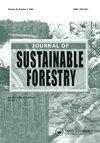臭氧胁迫下白皮松生长、生理及吸收特性的响应系统
IF 1.8
4区 农林科学
Q3 FORESTRY
引用次数: 0
摘要
目的:研究臭氧(O3)胁迫下白皮松(Pinus bungeana)生长、生理及吸收特性的变化,阐明各项指标之间的相关性,确定其对臭氧的响应程度。方法:采用3个浓度梯度(NF:正常大气O3浓度,NF40:正常大气O3浓度+ 40 nmol /mol;采用相关分析、冗余分析和方差分析等方法,研究不同O3浓度下白皮松特性之间的关系。结果:(1)株高生长(ΔH)、50 cm处直径生长(ΔDBH)、气孔大小(S)、气孔密度(M)、气孔开度(K)、气孔导度(Gs)、净光合速率(Pn)、蒸腾速率(Et)、水分利用效率(WUE)、最大光化学效率(Fv/Fm)、叶绿素含量(CHL)、全树耗水量(W)、O3吸收率()均随O3浓度的增加而降低;细胞间CO2浓度()和相对电导率(L)随O3浓度的增加而增加;(2) O3胁迫下白皮松生长指标(ΔH, ΔDBH)与O3吸收状态(,W)的相关性最大,其次是光合指标(,WUE,,,),生长指标(ΔH, ΔDBH)和气孔特征(K, M, S),部分生理指标(L,)与光合(,WUE…)和气孔(K, M, S)的相关性较弱;(3)白皮松各指标在NF和NF80的O3处理下差异均显著(P < 0.05), ΔH、ΔDBH、M、CHL、、W在NF和NF40处理下差异最为显著,K、S、WUE,,,, L在NF40和NF80处理下差异更为显著。结论:实验证明,长期暴露在高浓度的O3环境下,白皮松生长缓慢,光合能力降低,对O3的吸收能力进一步降低。白皮松的生长与O3吸收特性的变化关系最为密切,气孔特性与光合生理特性关系最为密切,而光合能力的降低等又进一步导致了其生长的缩减。本文章由计算机程序翻译,如有差异,请以英文原文为准。
The response system of the growth, physiological and uptake characteristics of Pinus bungeana under ozone stress
Objective: To study the changes of growth, physiological and absorption characteristics of Pinus bungeana under ozone (O3) stress, to elucidate the correlations among the indicators, and to determine its degree of response to O3. Methods: The growth, physiological characteristics and O3 uptake capacity of Pinus bungeana seedlings were measured in an open-top O3 fumigation manual control experiment with three concentration gradients (NF: normal atmospheric O3 concentration, NF40: normal atmospheric O3 concentration plus 40 nmlol/mol; NF80: normal atmospheric O3 concentration plus 80 nmol/mol), and the relationships between the characteristics of Pinus bungeana under different O3 concentrations were investigated with correlation analysis, redundancy analysis and analysis of variance. Results: (1) Plant height growth (ΔH), diameter growth at 50 cm (ΔDBH), stomatal size (S), stomatal density (M), stomatal opening (K), stomatal conductance (Gs), net photosynthetic rate (Pn), transpiration rate (Et), water use efficiency (WUE), maximum photochemical efficiency (Fv/Fm), chlorophyll content (CHL), whole tree water consumption (W), and O3 uptake rate () all decreased with the increase of O3 concentration; while intercellular CO2 concentration () and relative conductivity (L) increased with the increase of O3 concentration; (2) growth indicators of Pinus bungeana under O3 stress (ΔH, ΔDBH) were the most correlated with O3 uptake status (, W), followed by photosynthetic indicators (, WUE, ,, ) and growth indicators (ΔH, ΔDBH) and stomatal characteristics (K, M, S) under O3 stress, some physiological indicators (L, ) were relatively weakly correlated with photosynthesis (, WUE,,, ) and stomatal (K, M, S); (3) all the indicators of Pinus bungeana were significantly different under O3 treatments of NF and NF80 (P < 0.05), ΔH, ΔDBH, M, CHL, , , W and were most significantly different under NF and NF40 treatments, and K, S, WUE, , , , L were more significantly different under NF40 and NF80 treatments. Conclusion: The experiment proved that the growth of Pinus bungeana was slowed, photosynthetic capacity was reduced, and the absorption capacity of O3 was further reduced by long-term exposure to high concentration of O3. The growth of Pinus bungeana was most correlated with the changes of O3 absorption characteristics, and the stomatal characteristics were most correlated with photosynthetic physiological characteristics, and the reduction of photosynthetic capacity etc. further led to the curtailment of its growth.
求助全文
通过发布文献求助,成功后即可免费获取论文全文。
去求助
来源期刊

Journal of Sustainable Forestry
Social Sciences-Geography, Planning and Development
CiteScore
3.90
自引率
12.50%
发文量
42
期刊介绍:
Journal of Sustainable Forestry publishes peer-reviewed, original research on forest science. While the emphasis is on sustainable use of forest products and services, the journal covers a wide range of topics from the underlying biology and ecology of forests to the social, economic and policy aspects of forestry. Short communications and review papers that provide a clear theoretical, conceptual or methodological contribution to the existing literature are also included in the journal.
Common topics covered in the Journal of Sustainable Forestry include:
• Ecology, management, recreation, restoration and silvicultural systems of all forest types, including urban forests
• All aspects of forest biology, including ecophysiology, entomology, pathology, genetics, tree breeding, and biotechnology
• Wood properties, forest biomass, bioenergy, and carbon sequestration
• Simulation modeling, inventory, quantitative methods, and remote sensing
• Environmental pollution, fire and climate change impacts, and adaptation and mitigation in forests
• Forest engineering, economics, human dimensions, natural resource policy, and planning
Journal of Sustainable Forestry provides an international forum for dialogue between research scientists, forest managers, economists and policy and decision makers who share the common vision of the sustainable use of natural resources.
 求助内容:
求助内容: 应助结果提醒方式:
应助结果提醒方式:


